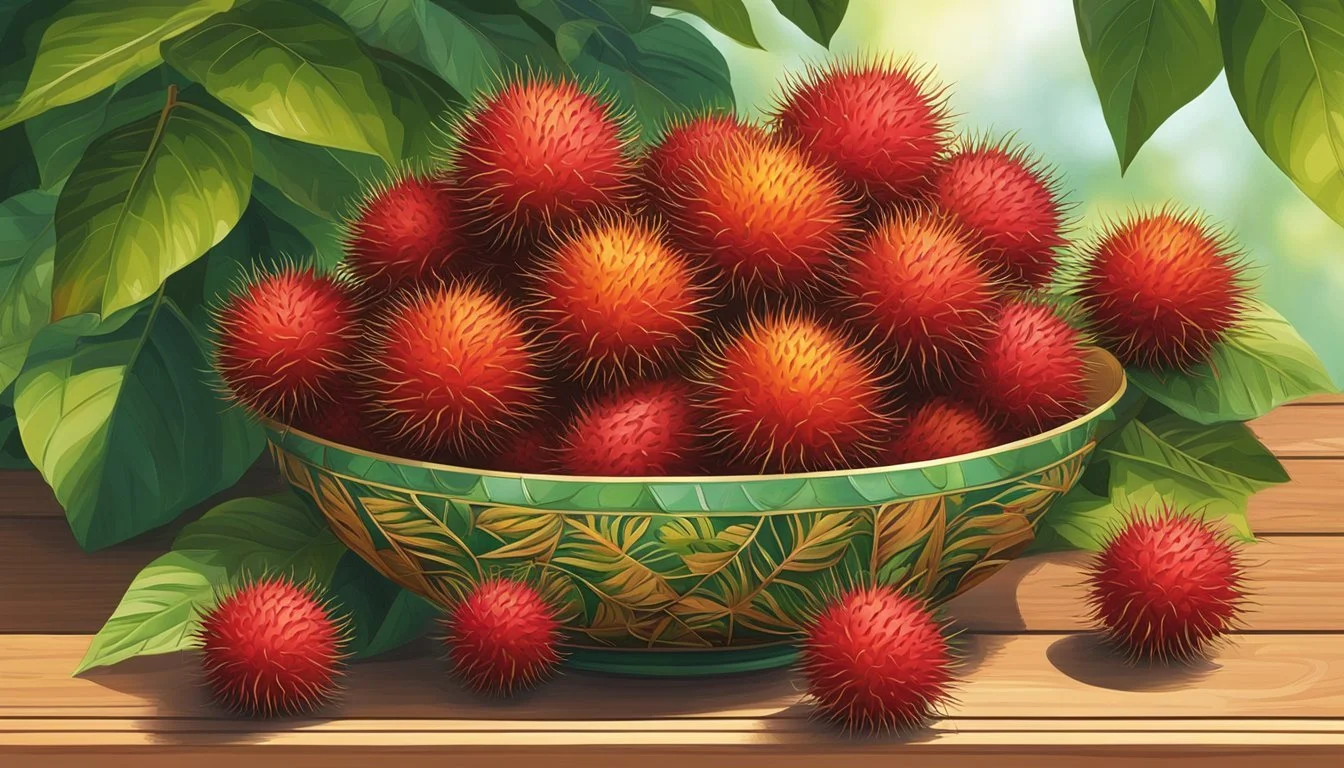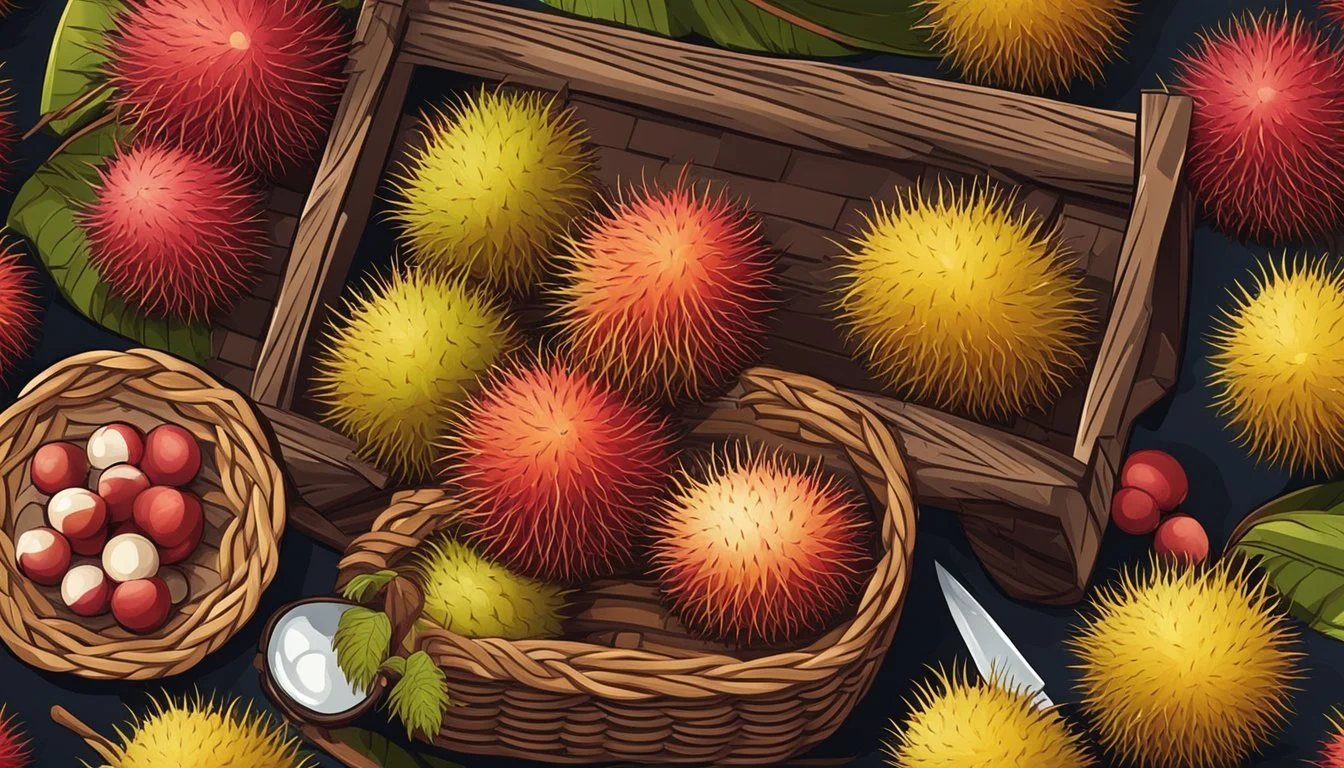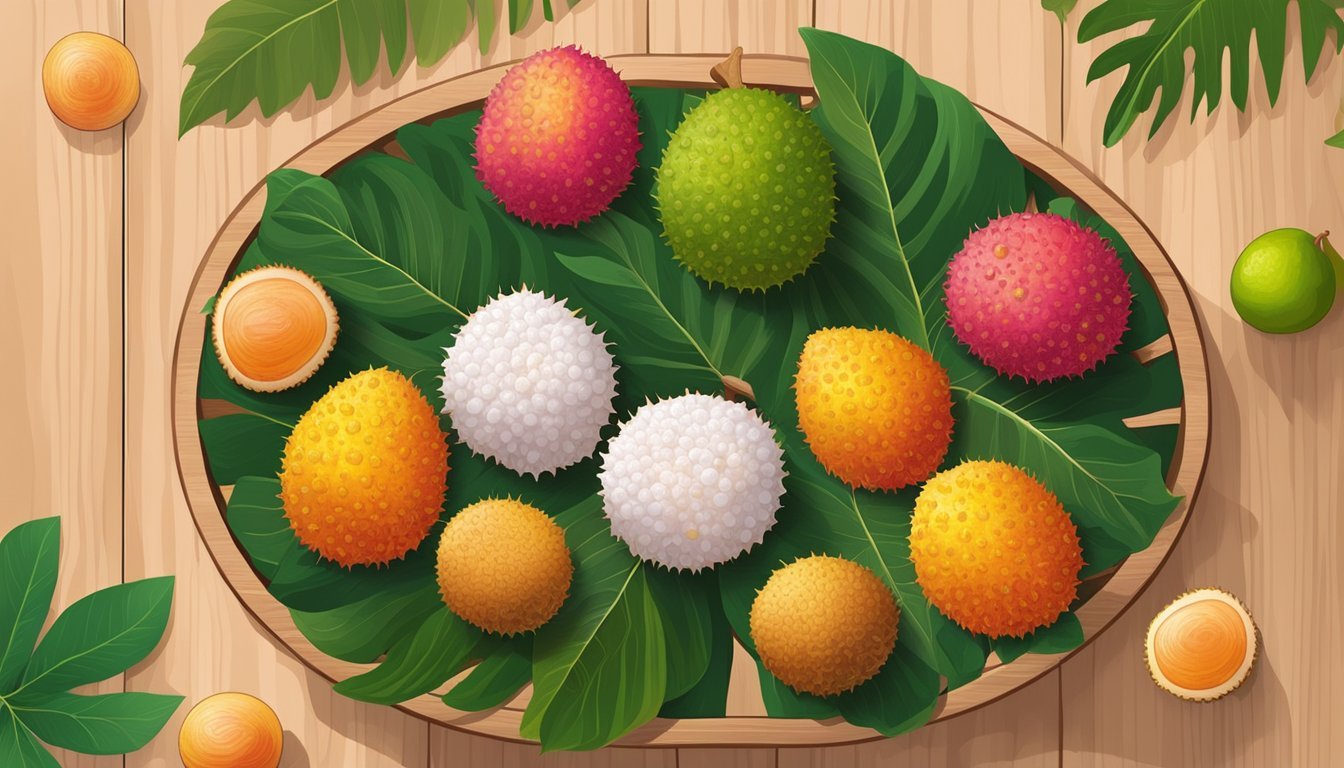Rambutan Substitutes
Top Alternatives for Unique Flavor and Texture
Rambutan, a tropical fruit native to Southeast Asia and scientifically known as Nephelium lappaceum, offers a unique mix of creamy sweetness and a slightly larger size than similar fruits. This exotic fruit, primarily grown in Malaysia, is packed with nutrients such as Vitamin C and antioxidants, making it a popular choice for both culinary and skincare applications.
Although rambutans can be hard to find outside of their native regions, some common substitutes can provide similar tastes and textures in recipes. Lychee and longan are excellent substitutes for rambutan due to their comparable sweetness and delicate textures. Both lychee and longan are also rich in nutrients and share similar culinary versatility, making them suitable alternatives when rambutan is unavailable.
When choosing the right substitute, consider the specific qualities of rambutan that you are trying to replicate in your dish. Lychee offers a similar balance of sweet and tart flavors with a floral aroma, while longan has a slightly musky taste and a softer texture. These subtleties can help you achieve the desired outcome in your culinary creations.
Nutritional Profile of Rambutan
Rambutan is a tropical fruit known for its diverse nutritional content, including essential vitamins, antioxidants, and minerals, making it not only delicious but also beneficial for overall health.
Vitamins and Antioxidants
Rambutan is particularly rich in vitamin C, a crucial nutrient for several body functions. A single 100-gram serving of fresh rambutan pulp can provide between 21.5 to 69.1 milligrams of vitamin C, fulfilling 24-77% of the Daily Value (DV). This vitamin is essential for collagen production, immune system support, and iron absorption.
Additionally, rambutan contains vitamin A, although in smaller quantities, which aids vision and skin health. The presence of antioxidants in rambutan, such as polyphenols, helps combat oxidative stress, protecting cells from damage and contributing to overall well-being.
Minerals and Other Compounds
Rambutan is also a good source of various essential minerals. It contains significant amounts of manganese, phosphorus, and iron. Manganese is crucial for enzyme function, while phosphorus is vital for bone health. Iron is necessary for the formation of red blood cells, helping prevent anemia.
Moreover, rambutan provides dietary fiber, which aids in digestive health and helps maintain a healthy gut. The fruit also boasts unique compounds like flavonoids and saponins, which may offer additional health benefits. Rambutan's low fat content and sweet, edible flesh make it a nutritious and enjoyable addition to the diet.
Culinary Uses of Rambutan
Rambutan's unique sweet taste and creamy texture make it a versatile ingredient in a variety of dishes. From simple preparations to creative recipes, preparing and incorporating rambutan can enhance both sweet and savory culinary creations.
Preparing and Peeling Rambutan
To enjoy rambutan, start by selecting ripe, fresh fruits. They should have bright red or yellow skin with flexible spines. Begin peeling the edible fruit by slicing gently through the peel with a knife, avoiding the flesh. Once you’ve made a slight cut, use your fingers to pull apart the skin and reveal the juicy flesh inside.
Ensure to remove the seed, which is not edible. The flesh can be consumed directly or used in various recipes. Preparation is key to preserving its sweet taste and creamy texture, making it a delightful addition to your culinary endeavors.
Incorporating Rambutan into Dishes
Rambutans add an exotic touch to fruit salads and desserts. Their sweet and juicy flesh complements other tropical fruits. They can also be used to create jams and preserves, where their flavor shines through.
For beverages, rambutans can be juiced to make refreshing drinks or incorporated into cocktails. They bring a special note to savory dishes as well, such as in curries or as garnishes for seafood. Experimenting with rambutans in both sweet and savory recipes opens up numerous culinary possibilities while highlighting their unique flavor profile.
Rambutan Storage Tips
Proper storage of rambutan is crucial to maintain its freshness and enjoy its unique flavor. Fresh and ripe rambutans need to be kept under optimal conditions to extend their shelf life.
Optimal Conditions for Freshness
Rambutans are best stored at room temperature if they will be consumed within a few days. They should be kept in a well-ventilated area to avoid moisture buildup, which can hasten spoilage.
For longer storage, rambutans can be kept in the refrigerator. Place the fruits in breathable bags or containers. Rambutans can also be frozen; peel and remove the seeds before storing in airtight containers or freezer bags. Freezing maintains their taste and extends their usability.
Ripeness and Shelf Life
Ripe rambutans generally have a bright red or yellow color and are slightly soft to touch. They typically last for 2-5 days at room temperature when fresh.
In the refrigerator, the shelf life extends up to two weeks. Frozen rambutans can last for several months while still retaining their flavor. Always check for signs of spoilage, such as browning or too much softness, to ensure the fruit is still good to eat.
Properly monitoring and adjusting storage conditions based on ripeness will optimize the enjoyment of this tropical fruit.
Popular Rambutan Substitutes
For those looking for alternatives to rambutan, there are several options. Lychee and Longan are two of the closest substitutes, sharing many similarities in flavor, appearance, and use. There are also other tropical fruits that can offer unique alternatives depending on the specific needs and preferences.
Lychee: A Close Relative
Lychee is often considered the most suitable substitute for rambutan due to its similar taste and texture. Both fruits belong to the Sapindaceae family and thrive in subtropical regions. Lychee has a crisp, juicy, and slightly acidic flavor compared to rambutan’s creamy and sweet profile.
In recipes, lychee can be used in equal quantities as rambutan. Just ensure that lychees are peeled and pitted before use, similar to how rambutans are prepared. Nutritionally, lychee is rich in vitamin C, antioxidants, and several other vitamins.
Its distinctive, spiky red skin contrasts with the smooth, hairy shell of rambutan, but once peeled, both fruits reveal a translucent, juicy flesh. This makes it visually appealing in dishes that highlight tropical fruits.
Longan: Another Similar Option
Longan, another member of the Sapindaceae family, is a small tropical fruit often compared to lychee and rambutan. It has a brown, brittle skin and is smaller than both lychee and rambutan. Once peeled, Longan’s flesh is sweet and juicy, similar in texture but slightly less tart compared to lychee.
Longan fruit is sometimes called “Dragon Eye” due to the appearance of its flesh and dark seed. Nutritionally, it is high in vitamins and beneficial antioxidants, making it a healthy alternative.
In culinary applications, longan can be swapped for rambutan in fruit salads, desserts, and beverages. Its distinct but mild flavor allows it to blend seamlessly in various dishes.
Other Tropical Fruit Alternatives
Besides lychee and longan, there are other tropical fruits that can serve as a substitute for rambutan based on the specific flavor and texture needed. Mangosteen is one such alternative, offering a sweet and tangy profile ideal for desserts and salads.
Another option is pulasan, which, like rambutan, has a sweet taste and juicy texture but with a softer and easier-to-peel skin. Mangosteen and pulasan belong to tropical fruit varieties that can adapt well in recipes requiring a balance of sweetness and tartness.
Dragon fruit also provides a unique option, offering a mildly sweet taste and vibrant appearance, making it suitable for visually striking dishes. These fruits contribute different nutritional benefits, including various vitamins and antioxidants.
Health Benefits and Potential Side Effects
Rambutan offers numerous health benefits such as boosting the immune system and aiding digestion, thanks to its vitamin content and antioxidants. It also has some associated side effects that need to be considered, like allergies and potential digestive issues.
Promoting Health with Rambutan
Rambutan is a rich source of vitamin C, which plays a crucial role in boosting the immune system and improving collagen production for healthy skin. A single cup of fresh rambutan provides a significant portion of the daily recommended intake of vitamin C for both men and women.
The fruit also contains beneficial antioxidants like flavonoids, phenols, and tannins. These compounds help combat oxidative stress, reducing the risk of chronic diseases.
Additionally, rambutan provides several essential minerals, including iron and calcium, which are important for bone health and preventing anemia. The fiber content in rambutan aids in digestion and promotes gut health, helping to prevent constipation and maintaining regular bowel movements.
Precautions and Side Effects
While rambutan is generally safe for consumption, potential side effects should not be overlooked. Some individuals may experience allergic reactions to rambutan, which can lead to itching, swelling, and difficulty breathing. It's important for those with known allergies to similar fruits to avoid rambutan without proper medical advice.
Overconsumption of rambutan, especially the canned variety with added syrup, can lead to digestive issues such as diarrhea and bloating. The high sugar content in canned rambutan might also affect blood sugar levels, making it less suitable for diabetics.
Moderation is key, and incorporating rambutan into a balanced diet can help mitigate these risks. Always consult a healthcare provider if unsure about its suitability for your diet.
Rambutan in Skincare
Rambutan is gaining popularity in skincare for its ability to support collagen production, improve skin elasticity, and combat fine lines. It is also a valuable substitute for retinol, especially for individuals with sensitive skin.
Skin Benefits of Rambutan Extracts
Rambutan is rich in antioxidants and vitamin C, which help to neutralize free radicals and decrease inflammation. This can protect the skin from oxidative damage and premature aging.
These extracts support collagen production and enhance skin elasticity.
Users may notice smoother skin texture and reduction in fine lines and wrinkles.
Rambutan is suitable for sensitive skin types, providing benefits without the irritation that some experience with traditional retinoids.
Retinol and Its Alternatives in Rambutans
Retinol is widely used for its anti-aging properties, but it can cause irritation in sensitive skin.
Rambutan serves as an effective alternative by stimulating collagen production and promoting cell turnover, much like retinol.
Combining rambutan with other retinol alternatives like bakuchiol or niacinamide can amplify skin benefits.
Products featuring this blend can offer powerful anti-aging effects, resulting in a well-rounded skincare routine.
Rambutan skincare products are available in various forms, including serums and moisturizers, making it easy to incorporate into daily regimens.
Cultivation and Varieties
Rambutan is a tropical fruit native to Southeast Asia, requiring specific climatic conditions for optimal growth. Its varieties offer a range of flavors and visual appeal, with cultivation practices influencing fruit quality and yield.
Growing Regions and Cultivation Methods
The rambutan tree thrives in humid tropical climates with abundant rainfall. Countries like Indonesia and Malaysia are the primary cultivators due to their year-round tropical weather. Ideal annual rainfall for rambutan cultivation is between 60 to 80 inches (150 to 200 centimeters).
Soil type plays a crucial role, with well-drained, loamy soils being most favorable. Proper sunlight exposure and consistent watering are vital. While tall trees can reach up to 20 meters, breeders have developed low-growing varieties (up to 5 meters) to ease harvesting.
Different Varieties and Their Characteristics
Rambutan varieties exhibit diverse flavors, textures, and visual features. Common varieties include Rongrien, with its sweet and juicy taste, and Binjai, known for a slightly tart and crunchy texture. These varieties not only differ in flavor but also in size and color, ranging from bright red to deep yellow hues.
Rongrien: Sweet, juicy, bright red.
Si Chompu: Subtle sweetness, softer texture.
Binjai: Slightly tart, crunchy, deep red.
Lebak Bool: Balanced sweetness, firm texture.
The appearance of rambutan, often resembling bright red "hedgehogs" with green or red spines, adds to its exotic appeal. Each variety has distinct characteristics, making rambutan a versatile fruit for different culinary uses.
Special Considerations for Consumption
When incorporating rambutans and their substitutes into one’s diet, certain factors such as pregnancy, breastfeeding, and specific dietary needs should be taken into account. These considerations help ensure the fruit's health benefits while minimizing any potential risks.
During Pregnancy and Breastfeeding
Rambutans are generally safe during pregnancy and breastfeeding. They offer several benefits due to their nutrient profile, particularly their Vitamin C content and antioxidants. Vitamin C aids in immune support, while antioxidants help combat oxidative stress. The fruit's reasonable fiber content may also help with digestion, which can be particularly beneficial during pregnancy to alleviate constipation.
However, it’s advisable to consume them in moderation. Consuming 2-4 rambutans per day can provide necessary nutrients without excessive sugar intake. It is crucial to ensure the fruits are fresh and properly washed to avoid any potential contamination. If there’s any doubt about incorporating rambutans into the diet, consulting with a healthcare provider is recommended.
Nutritional Advice for Specific Diets
Rambutans and their substitutes fit well into a variety of dietary plans, notably those focused on boosting antioxidant intake and enhancing digestion. The fiber in rambutans aids digestion and may benefit those on high-fiber diets or with specific digestive health goals.
For individuals monitoring their sugar intake, such as those on ketogenic or diabetic diets, caution should be exercised due to the fruit's natural sugars. Eating no more than the recommended serving size can help manage sugar levels. The fruit's Vitamin C content also contributes to immune health, and may be particularly advantageous for vegans and vegetarians who might need additional sources of the vitamin. When substituting lychees for rambutans in recipes, ensuring similar portion sizes can maintain the nutritional balance.
Tables and lists are utilized minimally due to the nature of the content but can be elaborated upon if more specific data or comparisons between fruits are necessary for the reader.
Botanical Insight
Rambutan, known for its unique appearance and sweet, juicy flesh, belongs to a notable botanical family. It holds a significant place in Southeast Asian agriculture and culture.
Rambutan's Place in Sapindaceae Family
Rambutan (Nephelium lappaceum) is a tropical fruit that belongs to the Sapindaceae family. This family also includes other distinguished fruits like lychee and longan. The Nephelium genus is recognized for its distinctive hairy exterior, reminiscent of a sea urchin, that protects the fruit's juicy aril inside.
The rambutan's nutritional value and distinct taste make it a popular choice in local markets. Its vibrant red rind turns bright red or yellow as it ripens. Farmers in Southeast Asia have cultivated rambutans for centuries, emphasizing its importance in the regional diet and economy.
Understanding the Rambutan Tree
The rambutan tree thrives in tropical climates and can grow up to 20 meters tall. Native to Malaysia and Indonesia, the tree prefers well-drained soils and plentiful sunlight. It produces clusters of fruits that hang from the branches, with each fruit enveloped in a thick, hairy rind.
The tree's flowers are small, white, and fragrant, attracting various pollinators. The rambutan takes several months to mature from flower to harvestable fruit, usually between June and August. The cultivation of rambutan trees requires careful management to ensure healthy fruit production and to maintain tree vitality over the years.









